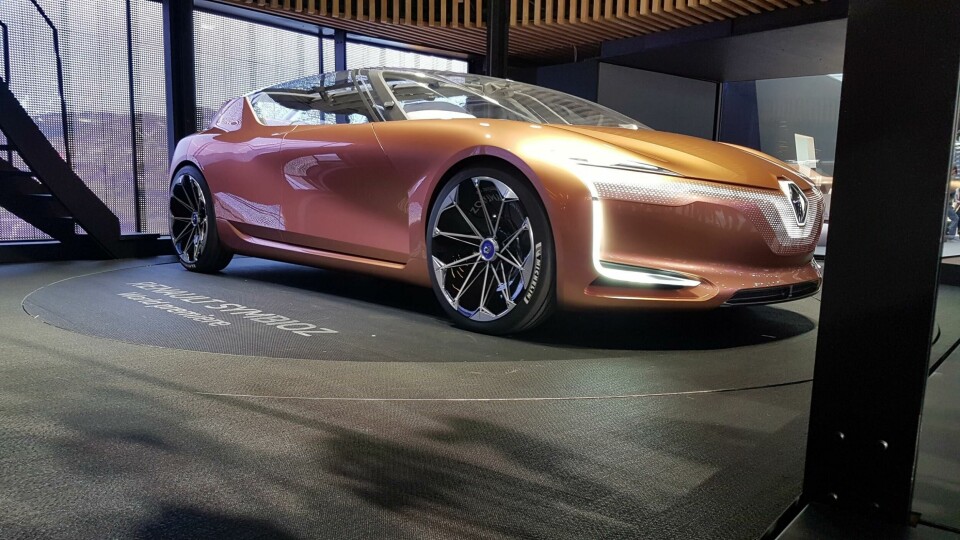
Frankfurt 2017: Stéphane Janin on the Renault Symbioz
Stéphane Janin, the man in charge of Renault’s concept cars, talks us through their new bronze, autonomous piece of home decor
“The first word that led the project was ‘ecosystem’,” says Stéphane Janin, Renault’s director of concept cars. “We just thought it would be great if a car and its environment would fit, would be working together, and the car would really be part of the ecosystem – without losing the personality of the car, the freedom a that a car can give to you.”

The Symbioz concept is possible due to new technologies, Janin explains: autonomous driving, a zero-emissions all-electric powertrain, and digital connectivity, involving a smart-grid linkage by which the car can store and provide energy for the house as well as a full suite of IoT-enabled controls for smart-home functionality.
“Thanks to these new technologies we thought wow, we can make something completely new,” he says. “We try to merge your car and your home, because your car is surely just an extra room really: you can remove the steering wheel and it’s become a new living space.”

The Symbioz is both figuratively and literally part of the house: Renault’s show-stand display in Frankfurt had it moving (driverlessly) in and out of a mocked-up glass-box living-room via sliding – ‘French’ – doors, and in the conceptual house, it can be moved up to a first-floor terrace on a raised platform. The furniture and upholstery of the room match the car’s configurable, multi-mode interior: the textured pale felt textile of the car’s seats with the sofa, the Yves Klein blue of the accessories such as cushions, seatbelts and a removable rucksack, the porcelain trim detailing with the tableware.

It builds upon ideas explored in the Trezor (Paris motor show, 2016), including the use of vacuum-laminated white ash for structural elements around the IP, developed by wooden bicycle-maker KEIM. “Trezor, if you remember, we used wood, so we kept working on that,” says Janin.
“We used the same wood, which is a high-tech wood, very lightweight with a specific process, and we also used marble [trim detailing] to match the house, but very thin layers of marble, not to be too heavy. The textile is by a designer [Aleksandra Gaca] from the Netherlands, specifically designed for us, for a feeling of furniture design inside the car.”

Yet Janin is clear that the Symbioz is still very much a car, and this is communicated in the approach taken with the exterior design. Rather than creating a very architectural car with more obvious visual connections to the house – the same forms, or by using cubic shapes, perhaps – “I think it’s important to keep a car for what it is, an object which is moving, which has to be really efficient, especially today,” he says. “So it’s very aerodynamic, it looks like a car.”

Though conceived as a comfortable family car, the Symbioz bears a very clear relationship to the Trezor. “We are really happy with this sensual design, very inspired by the body, so that’s something we keep,” Janin explains.
“It was interesting because on Trezor, the sports car, it’s kind of obvious to make very sensual shapes like old cars from the ‘60s, these racing cars like the Ferrari 250 GTO, for example, but for a family car’s that something a bit more difficult. But I think it works! It was really interesting to try to give this very plein [‘full’, or ‘voluptuous’, shape], almost heavy but not in a bad way, like creamy; weight but in a good, sensual way. And the contrast with the upper structure, which is very tight, lightweight, super-high-tech, I think that was what we looked for.”

The glass and polycarbonate roof, with its flip-up panels giving extra headroom for entry and exit, does allude to the house nonetheless. “It’s like floating black elements, very transparent, crystal-clear,” says Janin. “That’s the influence from the architecture, only on the upper structure, really.”
The steel-framed ‘H33’ smart-house, designed for Renault by Marchi Architectes, nods to the early modular and prefabricated homes of the 1920s and ‘30s, said to have been inspired by car design, and Renault has already directly referenced a relationship between car and home with the 2015 Le Corbusier concept, celebrated at the Villa Savoye.

For the Symbioz, this is wrapped up with the choice of paint for its carbonfibre exterior: it follows the metallic theme in this current series of concepts - the ‘magnesium’ Trezor and the gold tail end of the RS Vision 2027 (Shanghai, 2017) – with copper paint “because it’s very warm, and it goes inside the house, so we didn’t want to be very aggressive,” Janin says.
Of course, Renault has a long heritage of homeliness and has often led the way when it comes to experiments with automotive living space; the Symbioz not only evokes both Vel Satis and Avantime, at least in its upper-level forms, but the original Espace – the car which created the whole MPV family-room-on-wheels genre in the first place. Technical and digital integration now take it a stage further.



